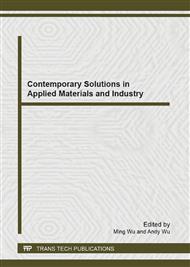p.35
p.39
p.44
p.49
p.54
p.59
p.65
p.70
p.75
Study on the Sewing Process of Automotive Seating Fabrics
Abstract:
Automotive seating fabrics are assembled into complete trims by sewing process, which plays an important role on the quality of automotive seat. This paper was written based on study of the influence of the distance between stitch and selvage, gauge distance, and the type of sewing thread on automotive woven seating fabric. Furthermore, the influences of each factor and the optimum parameters were obtained by the single-factor experiments and orthogonal experiment. The results showed that sewing strength and breaking elongation are increased with increasing the distance between stitch and selvage, and are decreased with the gauge distance. On the other hand, when the distance between stitch and selvage is 8cm, the gauge distance is 2cm, and the fineness of sewing thread is 168tex, its twist is 34.18, and the break strength 72.44N, sewing strength and elongation of this kind of seating fabric are the highest.
Info:
Periodical:
Pages:
54-58
Citation:
Online since:
April 2013
Authors:
Price:
Сopyright:
© 2013 Trans Tech Publications Ltd. All Rights Reserved
Share:
Citation:


